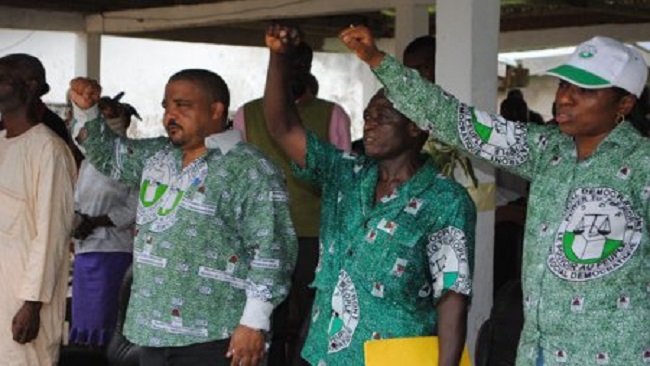Why Akere Muna, the NOW Movement and Joshua Osih will lose the French Camroun 2018 Presidential Elections
As it’s often said *’Politics is local’*. It is indeed local.
*Cameroons Electoral Political History*
At the Reunification of Cameroon in 1961, The Southern Cameroons (later West Cameroon) was an electoral Constituency (within which contested the various Southern Cameroons Political Parties).
While LRC (East Cameroon) had three Constituencies that voted along these lines (The Grand North – Fulanis, The Centre South – Betis and the West- Bamileke & Bassa).
*Case Precedent – 1992 Presidential Elections*
The results of the 1992 Presidential Elections displayed the following patterns;
*SDF* – won in the North West, South West, Littoral & West Regions.
*CPDM* – won in the Centre, South, East & Far North Regions.
*UNDP* – won in the Adamawa & North Regions.
Ever since the 1992 Presidential Elections till present, all electoral results have reflected the above patterns.
While the CPDM made inroads into the SDFs & UNDPs Constituencies, both the SDF and UNDP were reduced to Regional Political Parties as seen in the recent Senatorial Elections with the SDF winning only 7 seats of 70 contested seats. While the CPDM won 63 on 70 seats and the UNDP failed to win a single seat.
*Electoral Data*
*SDF*
Looking at the recent Electoral historical data Joshua Osih the SDFs candidate is destined to win less than 15% of the vote. And with Southern Cameroons/Ambazonia his constituency not taking part in the elections, Joshua Osih and the SDF may retain less than 10% of the vote.
*NOW MOVEMENT*
With the *NOW MOVEMENT* taking part in the elections for the first time, not representing any political party and with Ambazonia, Akere Muna’s constituency not taking part in the elections, Akere Muna is destined to win less than 5% of the vote.
*The CPDM*
This leaves the CPDM party and its candidate to win the remainder of the vote with at least 75% and the other 5% being won by other smaller parties like Maurice Kamto’s MRC.
This is based on recent Electoral data in which the CPDM won 56 seats in all 8 Regions of LRC and 7 seats in one of the two Regions in Southern Cameroons/Ambazonia. The above analysis is based on recent empirical data.
*The Wild Card – A Presidential Coalition of Opposition Political Parties/Movements*
Recent electoral data doesn’t prevent the Opposition parties from forming a coalition if they stand a chance of defeating the ruling party CPDM.
Based on recent Coalition Electoral data this coalition will have as members the SDF (Joshua Osih), MRC (Maurice Kamto), NOW Movement (Akere Muna), CDU (Adamou Ndam Njoya), CPP (Kah Walla) and any other smaller political parties.
Of all the above candidates only Maurice Kamto is from LRC and the rest of the candidates are from Southern Cameroons/Ambazonia whose constituency will not be taking part in the elections and whose constituency represent about 20 – 25% of the electorate.
Based on recent Electoral data any coalition will need to win the Grand North constituency (Adamawa, North and Far North Regions) which is currently in the grasp of the CPDM.
It should be noted that the Grand North constituency is the most populated constituency from recent population census data.
The possible best results for any such coalition of Opposition parties will be 20 – 30% of the vote which still leaves the CPDM with an outright victory of 70% of the vote considering Cameroon only conducts a Single round of votes at the Presidential Elections.
*The Southern Cameroons/Ambazonia Question*
With Southern Cameroons/Ambazonia having declared her independence on 1st October 2017 and currently engage in a guerilla warfare with the LRC Military it is difficult to see how up to 20% of the electorate in this part of the country will vote.
Also the Ambazonia Interim Government has prohibited the conducting of any LRC Elections within Ambazonia. The continous displacement of the population of Ambazonia and the reign of terror being executed on these populations by Military Forces from LRC indicates the majority of the populations of Ambazonia are in no mode to take part in elections being organised by a Government who has inflicted so much pain and terror on them.
*Reasons for Outright Southern Cameroons/Ambazonia Restoration of Independence*
The SDF was formed in 1990 with sole mission to restore the former State of West Cameroon. However with citizens from LRC taking much interest in the SDF party, the SDF NEC decided to take a shot at capturing the Presidency of LRC. The SDF candidate at the 1992 Presidential Elections John Fru Ndi came a close second with 36% of the vote, while Paul Biya of the CPDM won with 39% of the votes.
Ever since then the SDF has seen its electoral fortunes reduced and confined to the North West Region giving it a Regional party rather than National party status. This has convinced the majority of Southern Cameroonians/Ambazonians that the only option left to them is to support the Southern Cameroons/Ambazonia Interim Government to enable it restore the Southern Cameroons/Ambazonia’s Autonomy as was the case In 1961.
*Summary*
Based on the above analysis and recent electoral data, it is difficult to assume or predict how either Joshua Osih (SDF) or Akere Muna (NOW Movement) could win the 2018 LRC Presidential Elections.
However in politics nothing is permanent or predictable. I will conclude by stating in October 2018 (that is if the LRC Presidential Elections are held) the results will vindicate the above analysis.
By Oswald Tebit
The opinions expressed here are NOT that of the Cameroon Concord News Group





